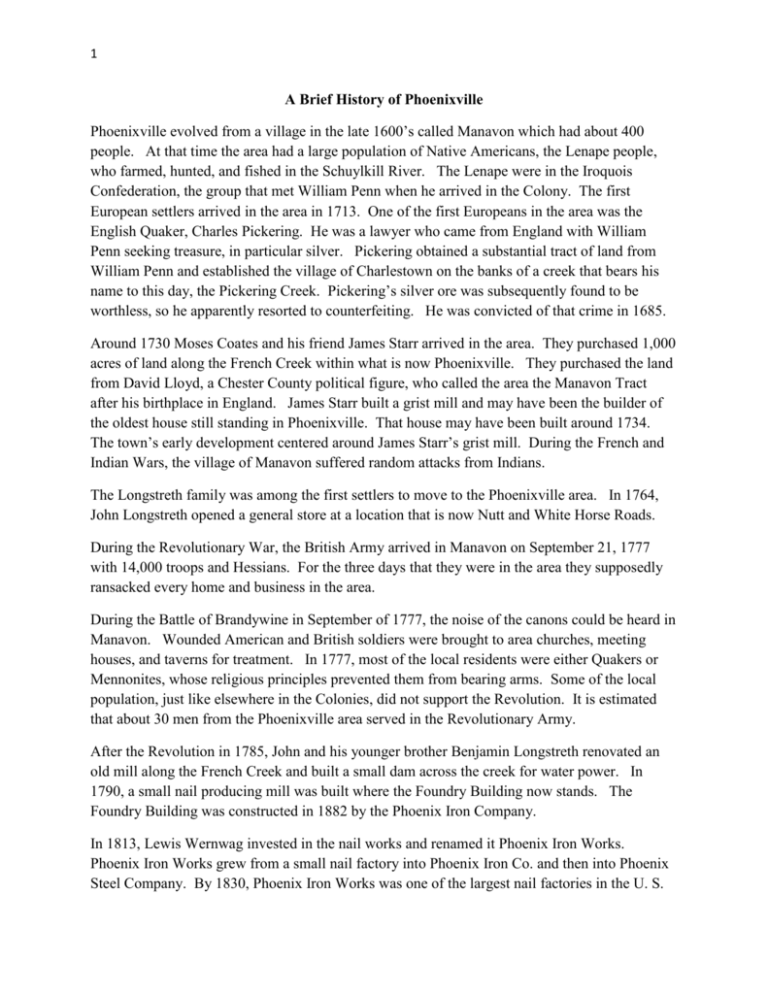click here - Historical Society of the Phoenixville Area
advertisement

1 A Brief History of Phoenixville Phoenixville evolved from a village in the late 1600’s called Manavon which had about 400 people. At that time the area had a large population of Native Americans, the Lenape people, who farmed, hunted, and fished in the Schuylkill River. The Lenape were in the Iroquois Confederation, the group that met William Penn when he arrived in the Colony. The first European settlers arrived in the area in 1713. One of the first Europeans in the area was the English Quaker, Charles Pickering. He was a lawyer who came from England with William Penn seeking treasure, in particular silver. Pickering obtained a substantial tract of land from William Penn and established the village of Charlestown on the banks of a creek that bears his name to this day, the Pickering Creek. Pickering’s silver ore was subsequently found to be worthless, so he apparently resorted to counterfeiting. He was convicted of that crime in 1685. Around 1730 Moses Coates and his friend James Starr arrived in the area. They purchased 1,000 acres of land along the French Creek within what is now Phoenixville. They purchased the land from David Lloyd, a Chester County political figure, who called the area the Manavon Tract after his birthplace in England. James Starr built a grist mill and may have been the builder of the oldest house still standing in Phoenixville. That house may have been built around 1734. The town’s early development centered around James Starr’s grist mill. During the French and Indian Wars, the village of Manavon suffered random attacks from Indians. The Longstreth family was among the first settlers to move to the Phoenixville area. In 1764, John Longstreth opened a general store at a location that is now Nutt and White Horse Roads. During the Revolutionary War, the British Army arrived in Manavon on September 21, 1777 with 14,000 troops and Hessians. For the three days that they were in the area they supposedly ransacked every home and business in the area. During the Battle of Brandywine in September of 1777, the noise of the canons could be heard in Manavon. Wounded American and British soldiers were brought to area churches, meeting houses, and taverns for treatment. In 1777, most of the local residents were either Quakers or Mennonites, whose religious principles prevented them from bearing arms. Some of the local population, just like elsewhere in the Colonies, did not support the Revolution. It is estimated that about 30 men from the Phoenixville area served in the Revolutionary Army. After the Revolution in 1785, John and his younger brother Benjamin Longstreth renovated an old mill along the French Creek and built a small dam across the creek for water power. In 1790, a small nail producing mill was built where the Foundry Building now stands. The Foundry Building was constructed in 1882 by the Phoenix Iron Company. In 1813, Lewis Wernwag invested in the nail works and renamed it Phoenix Iron Works. Phoenix Iron Works grew from a small nail factory into Phoenix Iron Co. and then into Phoenix Steel Company. By 1830, Phoenix Iron Works was one of the largest nail factories in the U. S. 2 Its maximum production was about three tons of nails per day. After a fire in 1848, the nail factory was destroyed and was never rebuilt. The name Phoenixville derives from the nail mill owner, Lewis Wernwag, looking at the fiery red hot iron which would later be rolled and flattened and commented that the heat reminded him of the Phoenix. The Phoenix is the mythical bird that dies and then rises from its own ashes. In the early 1820s, Phoenix Iron Works needed new capital. Brothers David and Benjamin Reeves and James and Joseph Whitaker added venture capital. In 1841, Reeves and Whitaker became the first firm in the area capable of extensive puddling operations after adding six puddling furnaces. A puddling furnace makes wrought iron from pig iron that is produced in a blast furnace. Pig iron that is produced in blast furnaces is brittle but can be poured into shaped cavities in sand to make products. Pig iron that is reheated to "burn out" the unwanted carbon so that it would be malleable and could be shaped by blacksmiths without cracking is called bar iron or wrought iron. In 1784, Henry Cort in England developed the "puddling" process to make wrought iron from pig iron. The process uses a furnace where coal is burned in a separate part and the hot air is drawn over the pig iron in the main part of the furnace. Long rods are used to oxidize out the unwanted carbon and to stir the iron. Coal was used in this process to generate the needed heat In the late 1830's, the Philadelphia and Reading Railroad came to Phoenixville. In September of 1837, the 1932 foot long Black Rock Railroad Tunnel was completed although the railroad did not open for business in Phoenixville until January of 1842. The tunnel was started in December of 1835. In 1842, the iron company blast furnace had a capacity for making 1,500 tons of pig iron per year. The refining furnace had equal capacity and the rolling mill could convert 3,000 tons of pig iron into bars per year. The mill employed 147 workers. In 1855, the iron company was reorganized and incorporated as the Phoenix Iron Company with David Reeves, founder, as president and his son Samuel as vice president and treasurer. The demand for iron railroad rails soared in the 1840s, Pennsylvania railroad trackage alone almost quadrupled between 1846 and 1860. The iron works at Phoenixville continued to lay the groundwork for a major role in the rail market. The first iron rails were rolled in November of 1846. At that time the company had three blast furnaces measuring l5' x 59'. In 1846, the firm changed its name to Reeves, Buck and Company, indicating a fresh source of capital had been obtained from Robert S. Buck of Bridgeton. Reeves, Buck and Company immediately put the new funds to work erecting a major rail mill along with other plant expansions. The 1840s represented a decade of triumph and expansion for the Reeves family, with the only major setback coming on June 25, 1848, when the nail factory burned. The nail facility was a total loss and it was never rebuilt. 3 By 1848, the town had about 3,337 residents. The growing area was incorporated as a Borough on March 6, 1849. In the 1850’s, Reeves, Buck and Company had the most substantial rolling mill in Pennsylvania, and in certain products such as rails it achieved total vertical integration. They had total control of the production process--from ownership of iron ore and anthracite coal to the production and sale of iron rails. In the 1850’s, the Phoenix Iron Co. placed an emphasis on production of structural iron beams John Griffen was named the superintendent at Phoenix Iron Co. in 1856. He developed the famous Griffen Gun. This spirally wrapped wrought-iron gun or rifle had been designed and first produced while John Griffen was still at the company’s mill in Safe Harbor in Lancaster County. The United States Army tested the gun at Fort Monroe, VA in 1856 and 1857, and was pleased with the product because exploding cannon shells were, at that time, a problem for the Army and Navy. The military purchased about 1,400 Griffin Guns from Phoenix Iron Co. between 1861 and 1865. It could fire a 6 pound shell in its 3” diameter barrel, which was a rifle. The Griffin Gun has been credited with being an important artillery weapon that helped the Union win the Civil War. Although the Civil War years brought contracts for the highly successful Griffen Gun, the success of the gun does not compare with the firm's greater claim to historical significance: the invention, fabrication, sale, and utilization of the famous Phoenix Column. It was invented by Samuel Reeves in 1862. The Phoenix Column is hollow and circular and made up of four, six, or eight steel segments that are flanged and riveted together. Reeves had created a structural column that would greatly facilitate the construction of tall buildings by eliminating the need for brutally heavy and thick load-bearing walls. The Phoenix Column also had structural applications in bridges, viaducts, and elevated rail lines. Architect Alan Burham commented that a real advantage over a solid column was that the Phoenix Column could be riveted. That became important in the 1880s when designs for taller and taller buildings on narrow urban lots had to address wind bracing. Connections between riveted Phoenix Columns and beams were sufficiently rigid that wind bracing became a relatively simple task. By 1880, Phoenixville had experienced significant growth. Its streets were paved, many homes had been built, and many churches had been built as well. The iron products that were made by the Phoenix Iron Co. were sold around the country and were also exported. Iron products were used in numerous major bridges and rail bridges in the country and abroad as well. Phoenix Iron Co. helped build about 1,400 bridges. Unfortunately there were several major bridge collapses during construction that killed some workers. Phoenix Iron Co. started making steel in 1889. Pennsylvania’s Governor from 1903 to 1907 was Samuel Whitaker Pennypacker who was born in Phoenixville on April 9, 1843. As governor he enacted a number of progressive reforms including the creation of the PA State Police, the PA State Museum, the PA Departments of Health, Highways, and Mines and Fisheries. He signed into law the Child Labor Act of 1905, which set a minimum age and standard hours for young workers. He oversaw the completion of the new state capitol building in Harrisburg. He approved the state’s purchase of more than a 4 half million acres of land for state forests and tree nurseries as well as the state’s first 12,000 acres of game lands. He died in 1916. By the end of World War I, Phoenixville was experiencing growth in other manufacturing businesses and retail stores were expanding in the town as the population expanded. Phoenixville had five movie theaters including the Colonial, the Savoy, and the New Phoenix. The Colonial Theatre, circa 1903, featured The Blob, which was a 1958 science fiction film that was filmed in Phoenixville. It has since become a cult classic. The movie introduced actor Steve McQueen who made his debut performance in the film. In 1949, the Phoenix Iron Company was renamed the Phoenix Iron and Steel Company and in 1955 the name was changed again to the Phoenix Steel Corporation. Phoenix Iron Co. employed up to 2,500 workers during the two World Wars. After World War II, Phoenix Iron and Steel Co. and its new name Phoenix Steel Corporation began to decline from increased domestic and foreign steel competition and from competition from aluminum and reinforced concrete products. Phoenix Steel Corporation eventually closed and the last heat was on November 18, 1976. After Phoenix Steel closed as did some other smaller manufacturing firms in that general time frame, Phoenixville experienced some challenging economic times. However, Philadelphia’s suburban growth soon helped revitalize the town and now Phoenixville is growing and prospering. The Phoenixville population in July of 2009 was estimated to be 16,643, which was up from 14,788 in the 2000 Census.







